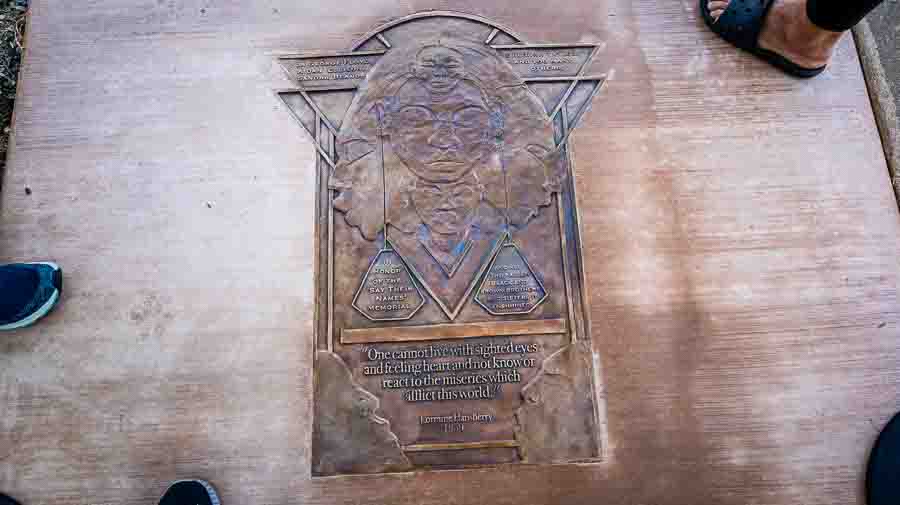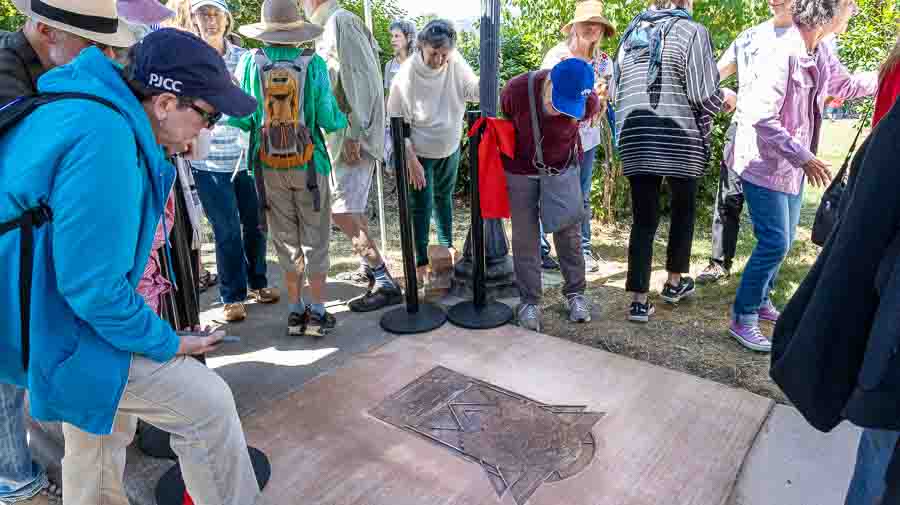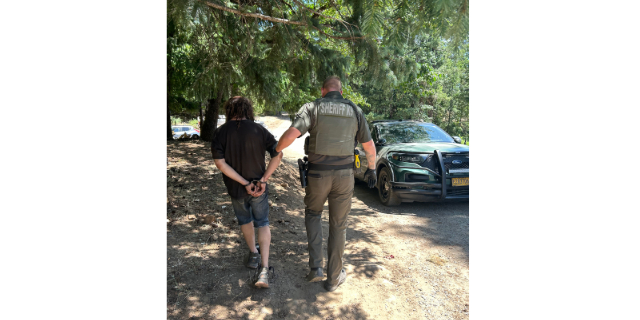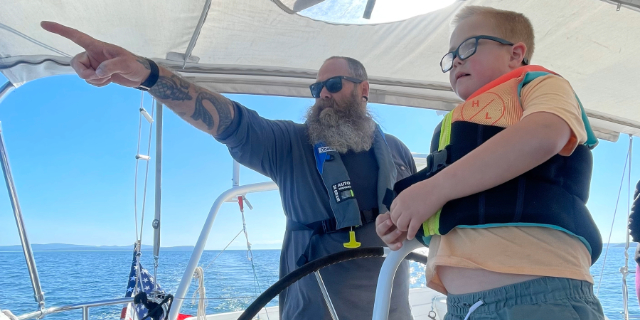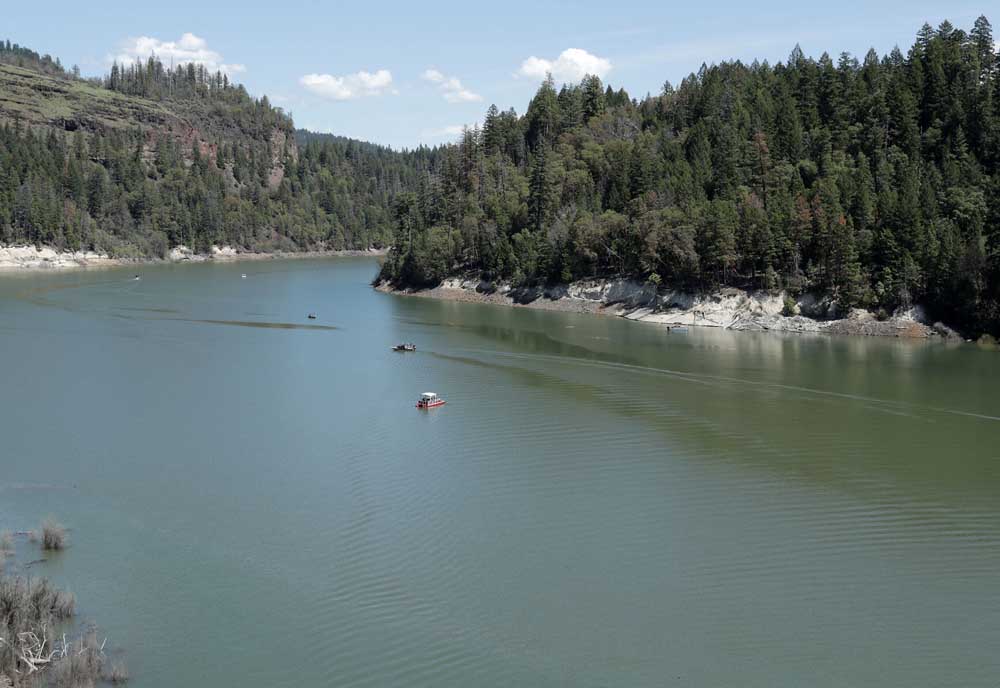“For George Floyd, Aidan Ellison, Sandra Bland, Breonna Taylor, and too many others
In honor of the ‘Say Their Names’ Memorial and all the fallen Black and brown brothers and sisters it enshrined.
Most Popular
‘One cannot live with sighted eyes and feeling heart and not know or react to the miseries which afflict this world.’
Lorraine Hansberry, 1959”
These words, captured on a 35-lb bronze plaque, now have a permanent home in the sidewalk along Railroad Park, at the intersection of A St. and 7th St. A formal unveiling took place Sunday afternoon.
The plaque is the result of collaboration from a wide array of Ashland organizations and institutions, including the city of Ashland and its Social Equity & Racial Justice Advisory Committee (SERJAC) and Public Arts Advisory Committee, the Playwrights Walk project and the Ashland Chamber Foundation, the Oregon Shakespeare Festival, and Southern Oregon University. The plaque was designed by Ashland artist Micah Blacklight and cast by Jack Langford of Langford Sculpture Studio in Phoenix.
“I have to tell you I’ve been doing a lot of racial justice work in the city and I have never had everybody come together for this in such a collaborative way,” Emily Simon, member and former chair of SERJAC, said afterwards.
“I really thought initially that it would be enough for me if it went into the ground… so many things could have gone wrong. Micah did all of this in 30 days… and it had to be that way because we had to get it in during the funding cycle, we had to get the approval… we had to get all the other city agencies to approve it… and we did. I always thought we were going to do this ribbon cutting because it deserved it, and I thought at the most we would have 30 people, and look at how many people were here!” Simon put the crowd count at close to 100.
“I’m almost in disbelief,” said Blacklight, also emphasizing the speed of the project. “Normally it takes way long — like stupid long — to get a public piece of art put down.”
Representatives of the many groups were on hand to speak on Sunday, as were members of the Say Their Names Collective, who maintained the T-shirt memorial initially put up in Railroad Park the summer of 2020 after the murder of George Floyd to honor victims of police and racial violence. The memorial had been vandalized and torn down multiple times, prompting discussions of a more permanent installation.
City Councilor Gina DuQuenne emceed the short event. “This is such a memorable, historic moment that we all get to bear witness to,” she said, before sharing the history of the T-shirt memorial and its effacement, noting “but this community came together every time and put them back up.” Then, gesturing toward the newly installed plaque: “All I have to say now is: snatch that off the fence!”
Emily Simon spoke next, urging community members to use the memorial and the day’s event as an “opportunity to teach those around us about what this means, and why this is here, and to use this plaque as a spot to gather and to remember, and to think about the next time that there is an incident of racial violence — as much as we don’t want it to happen — that people have a place to come, and that people have a place to object to it, and that people have a place to say, enough, no more.”
Susan MacCracken Jain of the Playwrights Walk project and the Public Arts Advisory Committee described the project’s potential “to honor Ashland’s history… and to continue to force ourselves to think about and shine a light — literally under the street light, so that’s an intentional placement there — to shine a light on ongoing issues of social justice and the work that we still all need to do.”
Black Alliance & Social Empowerment (BASE) Southern Oregon Vice President and Say Their Names Collective member Jess Friedman also spoke, focusing on the power of art:
“I think back on JoAnne Feinberg, and her courageous crew of artists who came out here at night and put out the original original art installation to educate us, to move us in a way that only art can … And just the way that everything we do, no matter how small, how crazy it seems, has such a ripple effect, to carry us forward, even when it feels like it might be nothing.”
Friedman was followed by Oregon Shakespeare Festival Artistic Director Tim Bond, who shared about the life of playwright Lorraine Hansberry, calling her his “muse,” “because her words and her activism have guided me my entire career.”
“Everyone who’s been doing what she’s been doing to try to keep the names all these people who were terribly murdered alive would be in real solidarity with Lorraine Hansberry,” said Bond. He also read the longer passage from Hansberry’s “A Raisin in the Sun” featuring the quote on the plaque:
“I have come to maturity, as we all must, knowing that greed and malice and indifference to human misery, bigotry, and corruption, brutality, and perhaps above all else, ignorance, abound in this world. One cannot live with sighted eyes and feeling heart and not know or react to the miseries which afflict this world.”
At last Micah Blacklight took center stage, holding a pair of giant scissors.
“So in this town there’s not a whole lot of brown,” Blacklight began. “But we’re here, right? And so the memorial that was put up on the fence, was put up by people who were not brown. But it was put up because they wanted the people who were to see, and be seen. And it worked, right?
“So it’s all the little steps — it’s all the overlapping — we have OSF, we have all these organizations, that have to come together in order for things to work. That’s what community is. We throw around the word, but that’s what it means. And this is the lived embodiment of it.”
Blacklight went on to lead the assembled crowd in a chant of “1, 2, 3, Yes!” as he cut the ribbon above the installation and the plaque was revealed.
There was more than one damp eye among both the speakers and attendees throughout the afternoon.
Even those less familiar with the previous memorial were moved by the event. Makhosazana Fletcher came with other members of the local Bahá’í community from Medford to participate. She did not previously know the history of the T-shirts, but reading the plaque for the first time she grew still: “This is beautiful… it just makes me a little emotional,” she said.
Jess Friedman used the same word: “I’m way more emotional than I thought I would be today,” she said as the event began to wrap up. “It feels so good and kind of surreal… this project started such a long time ago … me, Micah, Cassie [Preskenis], under Gina’s wing, meeting here every week to just see what we could do to preserve this… It’s really, really incredible seeing it in the flesh, and having people who want to bear witness to this, and, yeah, it feels really good.”
“I don’t have words to express my feelings, I really don’t,” Gina DuQuenne shared, speaking softly. “I’m just beyond… I really don’t have words.”
But then she found some:
“One thing I do want, is I want people to come, to look at it, to touch it, to read it. I want them to see it. I remember, I came and I saw the T-shirts on the fence and it just gave me so much pride, so much joy. I could see me, and people can see them, now and forever, in perpetuity. So for that I will always be grateful.”
Ashland resident and freelance journalist Meg Wade’s byline has appeared in Mother Earth News and other publications. Email Ashland.news at news@ashland.news. This story first appeared at Ashland.news.



